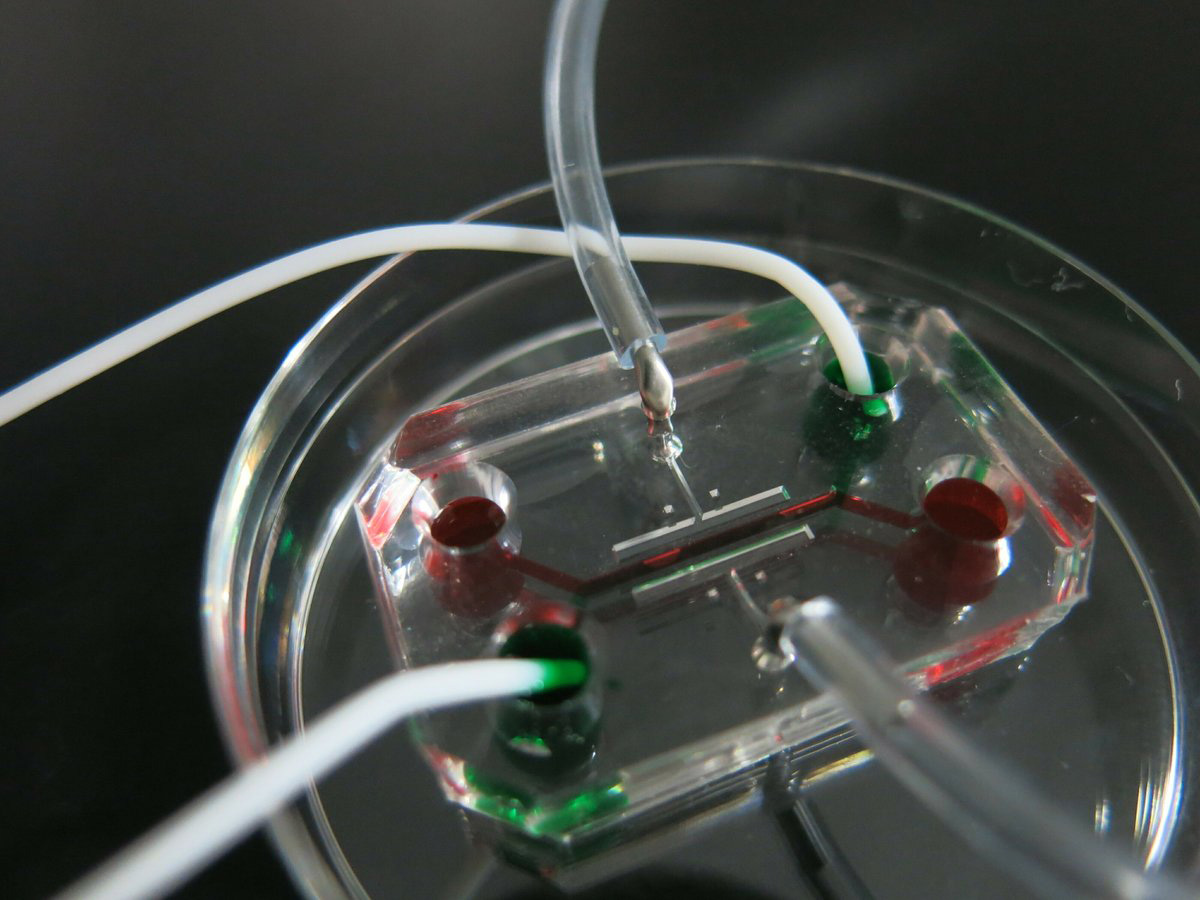
Research Activities
Research Activities
~Disruption of vascular endothelial barrier in respiratory organs by decreasing Claudin-5 expression~
Publications
September 27, 2022
A study using an organ-on-a-chip reveals a mechanism of SARS-CoV-2 invasion into blood vessels
~Disruption of vascular endothelial barrier in respiratory organs by decreasing Claudin-5 expression~
SARS-CoV-2 infects respiratory epithelial cells and then spreads to other organs via blood vessels. In this case, SARS-CoV-2 crosses the walls of blood vessels (the barrier of vascular endothelial cells) from respiratory organs and enters the blood vessels. However, the mechanism was unknown. The research group created an airway-on-a-chip that mimics respiratory organs consisting of airway epithelial cells and vascular endothelial cells. Using the device, they found that SARS-CoV-2 disrupts the vascular endothelial barrier by suppressing the expression of CLDN5, a protein involved in adhesive junctions between vascular endothelial cells, and by subsequently weakening the vascular endothelial cadherin-mediated junctions. The team confirmed that CLDN5 gene and protein expression levels were decreased in the lungs of a patient with COVID-19. They also demonstrated that increasing CLDN5 expression in vascular endothelial cells by gene transfer or small molecule drugs (fluvastatin) suppressed SARS-CoV-2-induced vascular endothelial barrier disruption.
These results indicate that suppression of CLDN5 expression is an essential mechanism for SARS-CoV-2-induced vascular endothelial barrier disruption, which increases the severity of COVID-19. The findings also indicate that up-regulation of CLDN5 expression is a new therapeutic strategy against COVID-19.
The airway-on-a-chip technology, which can be used to reproduce the respiratory pathology of COVID-19 and search for therapeutic agents, is expected to become an excellent tool for elucidating the pathogenesis of severe respiratory tract infections including COVID-19 and developing therapeutic drugs in the future.
The results of this study were published online in Science Advances on September 22, 2022.

Paper Details
- Journal: Science Advances
- Title: SARS-CoV-2 disrupts respiratory vascular barriers by suppressing Claudin-5 expression
- Authors:
Rina Hashimoto1#, Junya Takahashi2#, Keisuke Shirakura2, Risa Funatsu2, Kaori Kosugi1, Sayaka Deguchi1, Masaki Yamamoto3, Yugo Tsunoda4,5, Maaya Morita2, Kosuke Muraoka2, Masato Tanaka2, Tomoaki Kanbara2, Shota Tanaka2, Shigeyuki Tamiya6, Nagisa Tokunoh6,7, Atsushi Kawai2,6, Masahito Ikawa2,6,8, Chikako Ono6,8, Keisuke Tachibana2, Masuo Kondoh2, Masanori Obana2,9,10, Yoshiharu Matsuura6,8, Akihiro Ohsumi11, Takeshi Noda4,5, Takuya Yamamoto1,12,13, Yasuo Yoshioka2,6,7,8,9,10, Yu-suke Torisawa14, Hiroshi Date11, Yasushi Fujio2,8,9, Miki Nagao3, Kazuo Takayama1,15*, Yoshiaki Okada2,8*
# : Co-first authors, *:Corresponding authors - Author Affiliations:
- Center for iPS Cell Research and Application (CiRA), Kyoto University, Kyoto 606-8507, Japan
- Graduate School of Pharmaceutical Sciences, Osaka University, Osaka 565-0871, Japan
- Department of Clinical Laboratory Medicine, Graduate School of Medicine, Kyoto University, Kyoto 606-8303, Japan
- Laboratory of Ultrastructural Virology, Institute for Life and Medical Sciences, Kyoto University, Kyoto 606-8507, Japan
- Laboratory of Ultrastructural Virology, Graduate School of Biostudies, Kyoto University, Kyoto 606-8507, Japan
- Research Institute for Microbial Diseases, Osaka University, Osaka 565-0871, Japan
- BIKEN Center for Innovative Vaccine Research and Development, The Research Foundation for Microbial Diseases of Osaka University, Osaka 565-0871, Japan
- Center for Infectious Disease Education and Research (CiDER), Osaka University, Osaka 565-0871, Japan
- Institute for Open and Transdisciplinary Research Initiatives, Osaka University, Osaka 565-0871, Japan
- Global Center for Medical Engineering and Informatics, Osaka University, Osaka 565-32 0871, Japan
- Department of Thoracic Surgery, Kyoto University Hospital, Kyoto 606-8507, Japan
- Medical-risk Avoidance based on iPS Cells Team, RIKEN Center for Advanced Intelligence Project (AIP), Kyoto 606-8507, Japan
- Institute for the Advanced Study of Human Biology (WPI-ASHBi), Kyoto University, Kyoto 606-8501 Japan
- Department of Micro Engineering, Kyoto University, Kyoto 615-8540, Japan
- AMED-CREST, Japan Agency for Medical Research and Development (AMED), Tokyo 100-0004, Japan






















